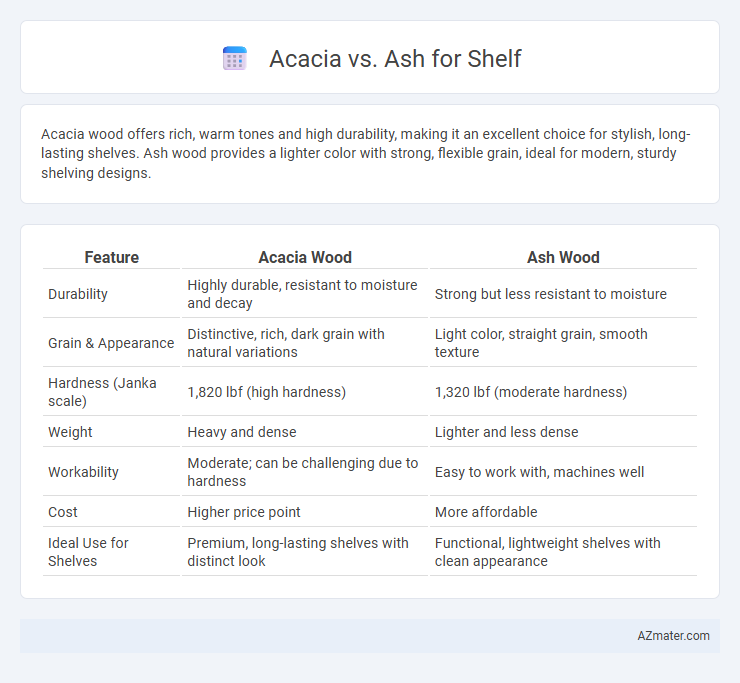Acacia wood offers rich, warm tones and high durability, making it an excellent choice for stylish, long-lasting shelves. Ash wood provides a lighter color with strong, flexible grain, ideal for modern, sturdy shelving designs.
Table of Comparison
| Feature | Acacia Wood | Ash Wood |
|---|---|---|
| Durability | Highly durable, resistant to moisture and decay | Strong but less resistant to moisture |
| Grain & Appearance | Distinctive, rich, dark grain with natural variations | Light color, straight grain, smooth texture |
| Hardness (Janka scale) | 1,820 lbf (high hardness) | 1,320 lbf (moderate hardness) |
| Weight | Heavy and dense | Lighter and less dense |
| Workability | Moderate; can be challenging due to hardness | Easy to work with, machines well |
| Cost | Higher price point | More affordable |
| Ideal Use for Shelves | Premium, long-lasting shelves with distinct look | Functional, lightweight shelves with clean appearance |
Introduction to Acacia and Ash Wood
Acacia wood, known for its durability and rich, vibrant grain patterns, offers excellent resistance to moisture and decay, making it ideal for sturdy and long-lasting shelves. Ash wood features a lighter color with a straight grain and exceptional strength, providing both aesthetic appeal and high load-bearing capacity for shelving applications. Both woods are hardwoods valued for their combination of beauty and resilience, but Acacia tends to be denser and more resistant to wear compared to the lighter, more flexible Ash wood.
Physical Characteristics of Acacia vs Ash
Acacia wood is renowned for its dense grain, rich amber hues, and natural resistance to moisture, making it highly durable and less prone to warping for shelves. Ash, characterized by its lighter color and straight grain, offers a smooth texture with excellent shock resistance but is generally less dense than Acacia. Both woods provide strength, yet Acacia's hardness and varied grain pattern create a more visually striking and sturdy shelf option compared to the more uniform and pale appearance of Ash.
Durability and Strength Comparison
Acacia wood offers exceptional durability with natural resistance to decay and insect attacks, making it ideal for long-lasting shelves. Ash wood provides impressive strength and flexibility, supporting heavier loads without bending or breaking. Comparing both, acacia is more resistant to environmental wear, while ash excels in structural robustness and shock absorption for shelving applications.
Aesthetic Appeal: Acacia vs Ash Shelves
Acacia shelves are prized for their rich, warm tones and striking grain patterns that create a rustic yet elegant aesthetic, making them a focal point in any space. Ash shelves, on the other hand, offer a lighter, more uniform color with subtle grain texture, providing a clean and modern appeal that complements minimalist and contemporary designs. The choice between Acacia and Ash hinges on whether a bold, natural statement or a sleek, understated look is desired for the shelf.
Workability and Ease of Finishing
Acacia wood offers excellent workability due to its moderate hardness and fine, even grain, making it easy to cut, sand, and shape for shelves. Ash provides superior ease of finishing with its light color and uniform texture, allowing stains and finishes to penetrate evenly for a smooth, polished look. Both woods are durable, but Acacia's natural oils enhance its resistance to moisture, while Ash's open grain may require sealing for optimal shelf longevity.
Maintenance and Longevity
Acacia wood offers superior durability and natural resistance to moisture and pests, requiring minimal maintenance with occasional oiling to maintain its rich color and prevent cracking. Ash wood, while strong and flexible, needs regular sealing and protection from moisture to avoid warping and surface damage over time. Acacia's denser grain structure typically ensures longer shelf life and less frequent upkeep compared to the more porous ash wood.
Environmental Impact and Sustainability
Acacia wood is often favored for shelves due to its fast growth rate and renewable sourcing, making it a more sustainable choice compared to Ash, which grows slower and requires longer harvesting cycles. The carbon footprint of Acacia is generally lower because of its ability to sequester carbon quickly and its adaptability to various climates, reducing the need for intensive resource inputs. Ash, while durable, often comes from regions with slower forest regeneration rates, leading to potential deforestation concerns and a higher environmental impact over time.
Cost and Availability
Acacia wood is generally more affordable and widely available compared to ash, making it a cost-effective option for shelves. Ash is often pricier due to its strong grain pattern and durability, but it may be harder to find in certain regional markets. Choosing between these woods depends on budget constraints and local supply.
Best Uses: Which Wood for Which Shelf Type
Acacia wood offers exceptional durability and natural resistance to moisture, making it ideal for floating shelves and open shelving in kitchens or bathrooms where exposure to humidity is common. Ash wood, known for its light color and smooth grain, is perfect for decorative or display shelves in living rooms and offices due to its aesthetic appeal and ease of finishing. For heavy-duty storage shelves, acacia's hardness provides superior load-bearing capacity, while ash suits lighter loads and decorative purposes best.
Final Verdict: Acacia or Ash for Shelving
Acacia wood offers superior durability and a rich, warm color ideal for decorative shelving, while Ash provides a lighter, more uniform grain with excellent strength and shock resistance, making it suitable for functional storage solutions. For shelves requiring high load-bearing capacity and a clean look, Ash is often preferred due to its consistent texture and structural integrity. Choose Acacia for aesthetic appeal and natural resistance to wear, or Ash for robustness and a bright, airy finish.

Infographic: Acacia vs Ash for Shelf
 azmater.com
azmater.com